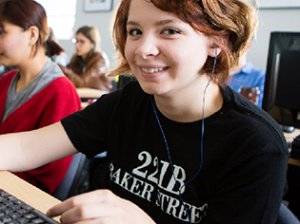How to Use Social Media to Strengthen Student Writing

When Advanced Placement and The National Writing Project surveyed teachers regarding social media use in the classroom, they found that 78% agree (26% strongly agree) that digital technologies “encourage student creativity and personal expression”. Digital tools of course give access to social media, which is a powerful outlet in and of itself to be able to harness in the classroom as a tool for communication. Which then begs the question, why can’t we leverage the power of social media outlets to help strengthen student writing?
Many of us know that with practice comes perfection, especially when it comes to writing. The more we write, the better we become as writers. Social media can be a tool where students are encouraged to use their creativity combined with personal expression to improve and strengthen their writing.
Blogging has become one of the primary platforms for teachers to use to help advance student communication. Blogging can be used as a tool to strengthen student writing through time. Some educators may, at first, be hesitant to accept blogging as a “formal” mode of writing. This is probably due to many years of teaching writing and academic essays. However, they will soon witness the benefits of blogging for students are so invaluable as a tool for communication.
Using Twitter as a mode of communication to improve writing has its benefits. Twitter as a platform inherently requires users to be short and brief, 140 characters brief. This mode of communication allows students to practice brevity and clarity. Using twitter can help them get to the point directly without using needless jargon in their writing. Twitter can also push them to not only be brief but also kind, empathetic and mindful when choosing their words.
Instagram as a platform is about the visual aspect. However, the caption component allows students to provide a brief description, outline, or a story to the visual they share. If you’re curious about how to use instagram in the classroom, check out my post Storytelling with Instagram,
These outlets strengthen student writing through:
Consistency: Teachers need to work out a plan with students to make writing on social media platforms a consistent practice in the classroom. Working with the students’ needs, skills and abilities would help the teacher and the student figure out a goal of how much writing needs to be done per week to improve on a specific set of writing skills.
Feedback: The power of peer feedback undeniably helps students to improve their writing. However, it also helps to foster a culture of writing accountability amongst peers. Peers now feel the need to write, comment and improve in order for them to share their work with their peers.
Confidence: Publishing work publicly is often a very nerve wracking and a scary experience for many students. Though with practice, encouragement, and positive feedback, students are able to gain confidence in themselves to be able to write and share more of their work in the digital world. This confidence doesn’t necessarily translate to stronger writing; however, the more confidence students have when it comes to writing, the more it’s an enjoyable task that they’re engaged with and actually look forward to doing.
Collaboration: When students are exposed to writing from their peers by way of feedback and collaboration, especially when it’s live collaboration (Google doc/Twitter), students are able to develop stronger ideas, find convincing evidence and be creative in composition generally.
In the same study above, 50% of teachers say today’s digital technologies make it EASIER for them to shape or improve student writing. There are so many reasons to incorporate the use of social media in the classroom, but one of the most important reasons is to help strengthen student writing.
This piece was originally submitted to our community forums by a reader. Due to audience interest, we’ve preserved it. The opinions expressed here are the writer’s own.